This pub is in on the first floor of the W12 Centre, opposite the Central Line underground station. The railway came to Shepherds Bush in May 1844, to close only a few months later. The first proper local service came with the opening of the Hammersmith and City Line, in 1864. The Central London Railway opened in 1900 and was renamed the Central Line in 1937.
A photograph and text about The Central Bar.
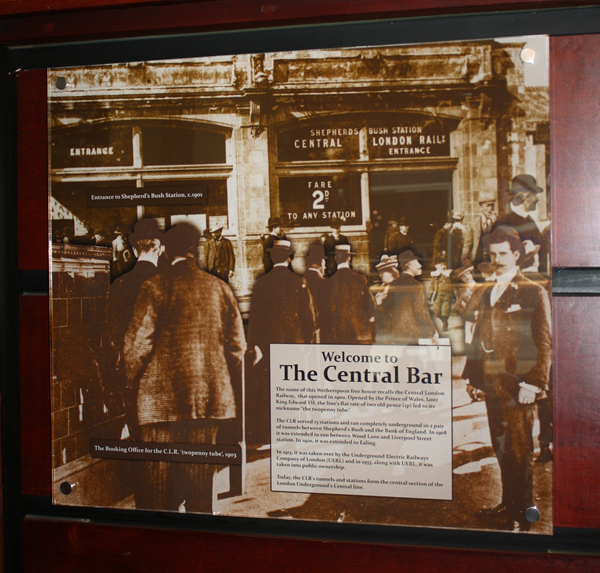
The text reads: The name of this Wetherspoon free house recalls the Central London Railway, that opened in 1900. Opened by the Prince of Wales, later King Edward VII, the line’s flat rate of two old pence (1p) led to its nickname “the twopenny tube”.
The CLR served 13 stations and ran completely underground in a pair of tunnels between Shepherd’s Bush and the Bank of England. In 1908 it was extended to run between Wood lane and Liverpool Street station. In 1920, it was extended to Ealing.
In 1913, it was taken over by the Underground Electric Railways Company of London (UERL) and in 1933, along with UERL, it was taken into public ownership.
Today, the CLR’s tunnels and stations form the central section of the London Underground’s Central Line.
A collection of photographs, illustrations and text about the local area.
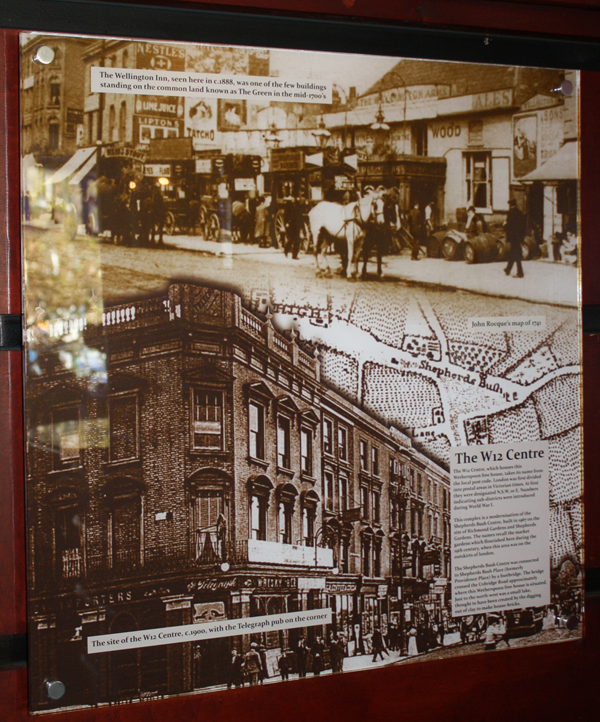
The text reads: The W12 Centre, which houses this Wetherspoon free house, takes its name from the local postcode. London was first divided into postal areas in Victorian times. At first they were designated N,S,W, or E. Numbers indicating sub-districts were introduced during World War I.
This complex is a modernisation of the Shepherds Bush Centre, built in 1967 on the site of Richmond Gardens and Shepherds Gardens. The names recall the market gardens which flourished here during the 19th century, when this area was on the outskirts of London.
The Shepherds Bush Centre was connected to shepherds Bush Place (formerly Providence Place) by a footbridge. The bridge crossed the Uxbridge Road approximately where this Wetherspoon free house is situated. Just to the north-west was a small lake, thought to have been created by the digging out of clay to make house-bricks.
The photographs/illustrations include (top left): ‘The Wellington Inn, seen here in c.1888, was one of the few buildings standing on the common land known as The Green in the mid-1700’s’; (middle right) ‘John Rocque’s map of 1741’; (bottom left) ‘The site of the W12 Centre, c.1900, with the Telegraph pub on the corner’.
An illustration captioned The Little Wonder of the Great City – an engine on the Twopenny Tube.
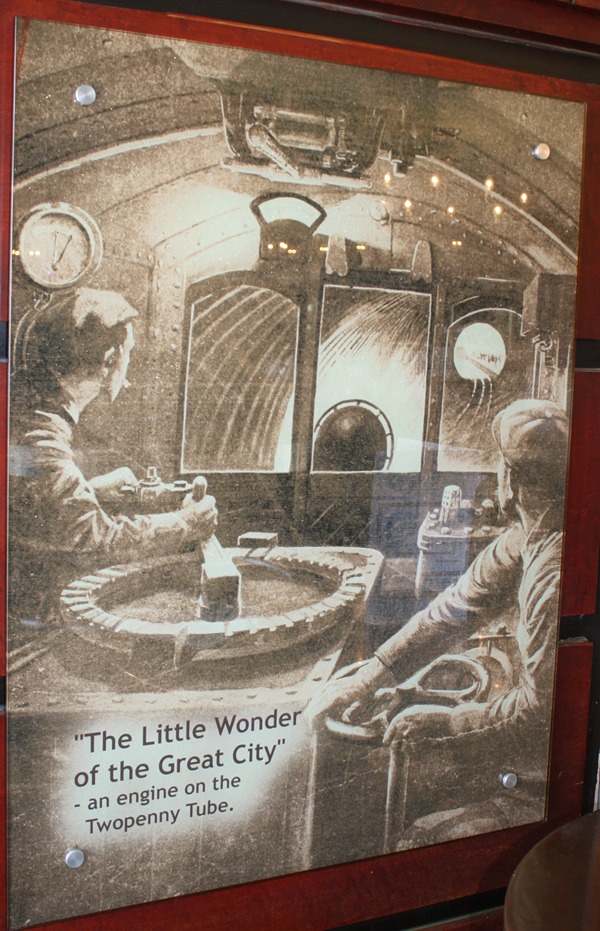
A collection of photographs and text about the history of BBC television.
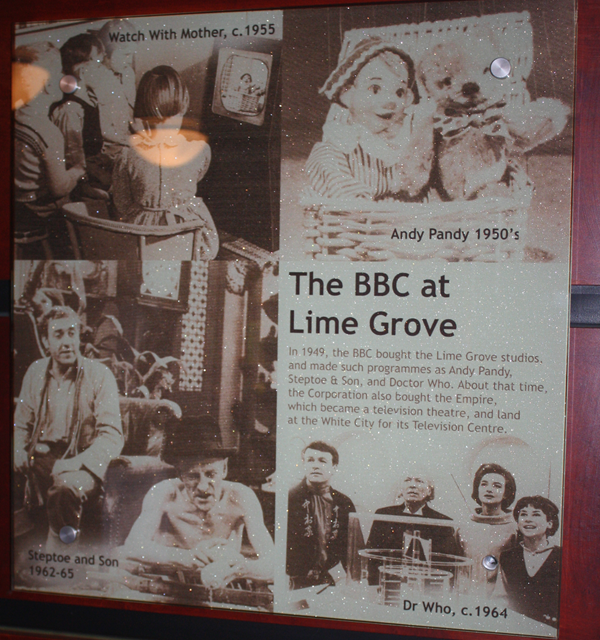
The text reads: In 1949, the BBC bought the Lime Grove studio, and made such programmes as Andy Pandy, Steptoe & Son, and Doctor Who. About that time, the Corporation also bought the Empire, which became a television theatre, and land at the White City for its Television Centre.
Photographs are entitled (clockwise, from top left): ‘Watch With Mother, c.1955’; ‘Andy Pandy 1950’s’; ‘Dr Who, c.1964’; ‘Steptoe and Son 1962-65’.
A collection of photographs and text about the stage and screen.
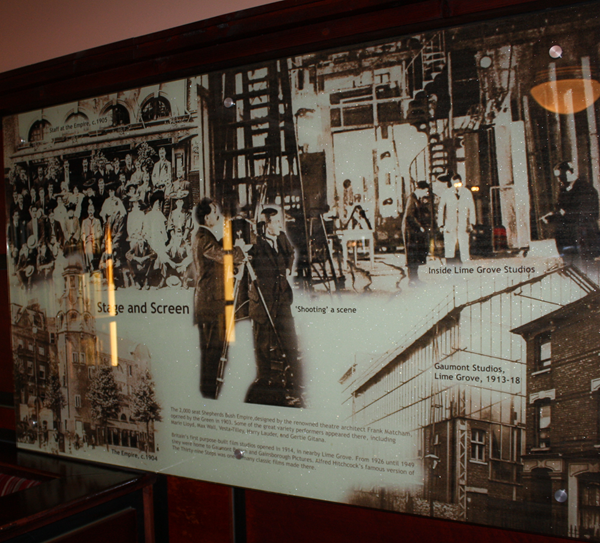
The text reads: The 2,000 seat Shepherds Bush Empire, designed by the renowned theatre architect Frank Matcham, open by the Green in 1903. Some of the great variety performers appeared there, including Marie Lloyd, Max Wall, Vesta Tilley, Harry Lauder and Gertie Gitana.
Britain’s first purpose-built film studios opened in 1914, in nearby Lime Grove. From 1926 until 1949 they were home to Gaumont British and Gainsborough Pictures. Alfred Hitchcock’s famous version of The Thirty-nine Steps was one of many classic films made there.
Individual photographs are entitled (top left): ‘Staff at the Empire, c.1905’; (top right) ‘Inside Lime Grove Studios’; (bottom right) ‘Gaumont Studios, Lime Grove, 1913-18’; (bottom left) ‘The Empire, c.1904’; (centre) ‘’Shooting’ a scene’.
A piece about the history of Shepherd’s Bush.
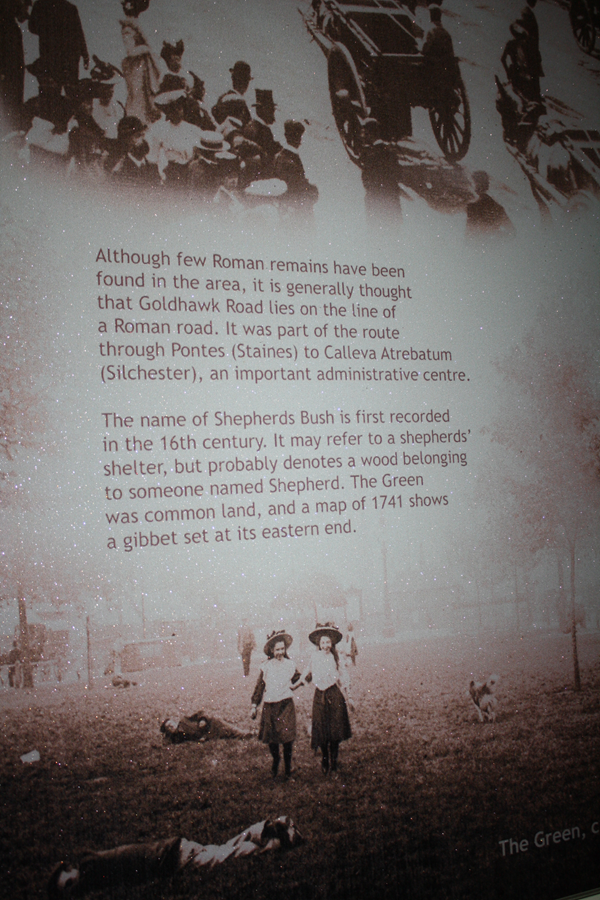
The text reads: Although few Roman remains have been found in the area, it is generally thought that Goldhawk Road lies on the line of a Roman road. It was part of the route through Pontes (Staines) to Calleva Atrebatum (Silchester), an important administrative centre.
The name of Shepherds Bush is first recorded in the 16th century. It may refer to a shepherds’ shelter, but probably denotes a wood belonging to someone named Shepherd. The Green was common land, and a map of 1741 shows a gibbet set at its eastern end.
A piece of text about the history of White City.
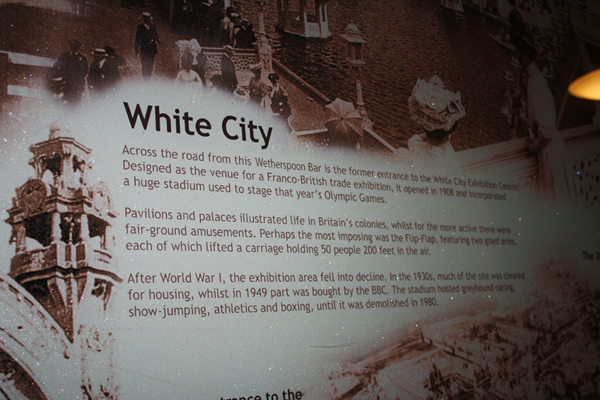
The text reads: Across the road from this Wetherspoon Bar is the former entrance to the White City Exhibition Centre. Designed as the venue for a Franco-British trade exhibition, it opened in 1908 and incorporated a huge stadium used to stage that year’s Olympic Games.
Pavilions and palaces illustrated life in Britain’s colonies, whilst for the more active there were fair-ground amusements. Perhaps the most imposing was the Flip-Flap, featuring two giant arms, each of which lifted a carriage holding 50 people 200 feet in the air.
After World War I, the exhibition area fell into decline. In the 1930s, much of the site was cleared for housing, whilst in 1949 part was bought by the BBC. The stadium hosted greyhound racing, show-jumping, athletics and boxing, until it was demolished in 1980.
A piece of text about the history of Shepherd’s Bush.
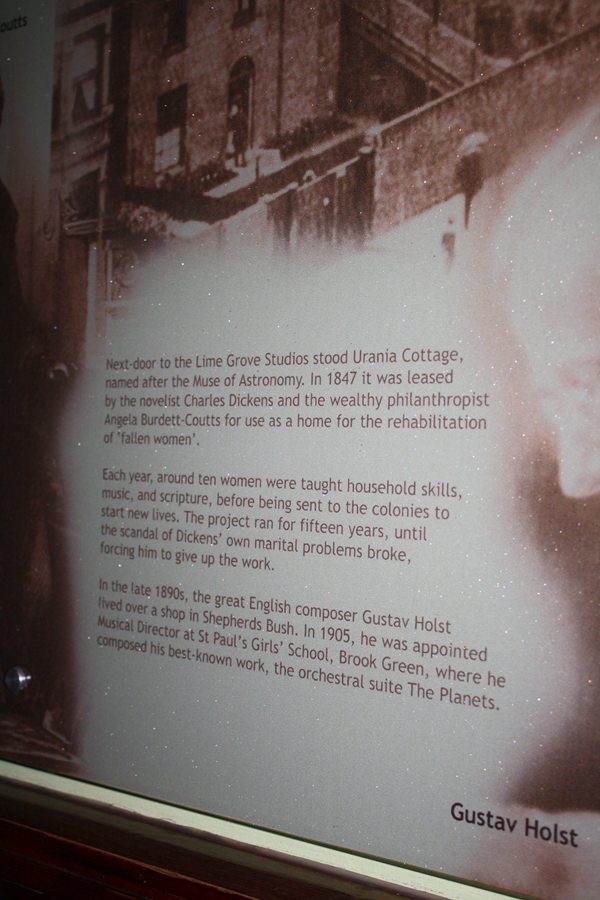
The text reads: Next-door to the Lime Grove Studios stood Urania Cottage, named after the Muse of Astronomy. In 1847 it was leased by the novelist Charles Dickens and the wealthy philanthropist Angela Burdett-Coutts for use as a home for the rehabilitation of ‘fallen women’.
Each year, around ten women were taught household skills, music, and scripture, before being sent to colonies to start new live. The project ran for fifteen years, until the scandal of Dickens’ own martial problems broke, forcing him to give up the work.
In the late 1890s, the great English composer Gustav Holst lived over a shop in Shepherds Bush. In 1905, he was appointed Musical Director at St Paul’s Girls’ School, Brook Green, where he composed his best-known work, the orchestral suite the Planets.
If you have information on the history of this pub, then we’d like you to share it with us. Please e-mail all information to: pubhistories@jdwetherspoon.co.uk